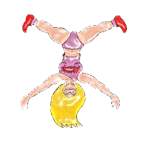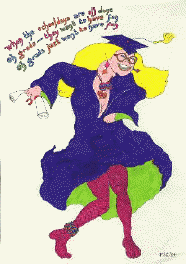

a furtive glimpse behind Skeeter
Kitefly’s
thrillingly condensed scenes
EPISODE TWO:
![]()
click on cartoon to view larger version
The Ups and Downs of Skeeter Kitefly
Skeeter Kitefly's Sugardaddy Confessor
_______________
Skeeter Kitefly's
Titular Assets
COMPACTIFICATION
behind the scenes
RoBynne O'Ring's
GRUNTS OF
PASSION
_______________
_______________
About the Author
_______________
Last Updated
July 26, 2010
You only live once, and usually not even then.
—Michael O'Donoghue
A Christmas cartoon I drew in 1983
expressly contrasted a tall rangy femme fatale
"as she was originally conceived and envisioned" with "the more compact
version, as she
actually turned out to be—for which the world is a happier (if somewhat
less quiet) place."
This More Compact Version, the protoSkeeter character, reappeared the
following spring in
the Commencement cartoon "Grads Just Want to Have Fun."
The embodiment of the Compact
Version was long-drawn-out. A new ingénue emerged at the end of
1984, in the rather gooey form of Melissa Chicale: "small, chic-shapely,
soft-voiced—even sticky-syrupy, very blonde, very blue-eyed, very fair ...
a chiffon dolly." Seen as an early convert to MTV, she
co-hosted a
hit-video broadcast that won her a recording contract and
Madonnalike superstardom.
In fact the unforeseen resemblance of
"Melissa Chicale" to "Madonna Ciccione" was too close, so
I altered her name
to "Pamela (Peaches) Beckett." Her persona would combine the mannerisms
of two impending archest rivals for four uneasy years.
Then in 1988 I was shown a striking piece of Crayolawork done by a little girl named Heather. "Heather with castanets on," I remarked (castanets being my ad hoc superlative for bells). Poe had written a poem about bells; I was seeking poetic notions; might I not write a poem about Heather with castanets on? Maybe so—if I could find a better name than "Heather" for its concentrated intense little subject. Aiming for something "short—COMPRESSED, in size, intensity—and TIME," I considered (happily not for long) such Seven Dwarfish prospects as Buzzy, Punchy, and Snubby.
Whatever her name, she needed to have a foredoomed quality: "Like Janis Joplin might have been had she been resuscitated and detox’d, her complexion pinkified and smoothified and her crinkly coiff begilded, but keeping the same incomparable cacklelaugh: a brassy puckish bacchanal who drove a huge magenta car called 'Delbert.'" From the very beginning, this incurable party girl "chaindrank margaritas, laughing so hard one time in midswallow that a slice of lime came up through her nose."
In January 1989 I came up with the name SKEETER. The poem "Skeeter with Castanets On"—including allusions to Carmen (suggested by the castanets) and The Chairs (whose opening line refers to mosquitoes) was completed in a three-day burst. Included in my debut Literary Submissions Package, it would be sent out eleven more times before being accepted by the Maverick Press, which published it in their April 1993 Culebra! issue—and nominated it for the Pushcart Prize, marking the zenith of my "legitimate" literary career.
Skeeter's first by-name appearance was definitely valedictory in tone:
Clacking the nights away in her everloving blue
Eyed flash-in-the-pants hurry to outseguidilla
Carmen intensely enhancing her own brevity
all the whileInsistent to the last that she'd dance rings around us
At ninety-four and even if you got deepseated
In an Ionescan sense why you could be happy
as a loon
"Her switch always flipped up, ever on, engorged for juiceless perpetuity, an eternal snuffed-out flame"—this was the primeval Skeeter image. When she made her second appearance in April 1989, however, she was very much alive and kicking—and skinny-dipping: "Those born to be hanged (quoth Skeeter) need never fear drowning."
With no more ado she made a quick immersion
and resurfaced, awhoop and spoutoffy,
at on-tiptoe chinlevel—which in Skeeter's
abbreviated case was scarcely past the shallows—
"Skeeter Skinny-Deeping," written in a single day, was published by The Duckabush Journal in November 1989: providing me with my first non-cartoon breakthrough, at long last, into public PRINT.
With the third Skeeter poem conceived in June 1989 as "The Ruby Yacht of Skeeter K——," a surname along Khayyámmy lines was clearly called for. KITEFLY, I felt, "looks seemly; works in with mosquito."
Reassessing Rebecca as Skeeter’s real name, I decided to retain it as a "tribute" to the effervescent young actress Rebecca Schaeffer, who'd co-starred with Pam Dawber in My Sister Sam and gone on to play Jacqueline Bisset's daughter in Scenes from the Class Struggle in Beverly Hills. In July 1989, like John Lennon, she was gunned down at her own front door by a demented fan; and the sudden obliteration of so much verve and charm deeply impressed me as being in keeping with the "ill-fated" image of Skeeter (Kelly Rebecca) Kitefly.
Attempts to proceed with "Ruby Yacht" got littlewhere—as I phrased it at the time—so in August I turned to a prose notion: "That Was Sven, This Is Mao." Written the following March, it introduced Skeeter's series of strange-eyed Scandinavian-looking ex-boyfriends" who, all too often, gave her the heave-ho:
And each time it happened she would shed her steppin'-out clothes, put on olive drabbery, and declare in a fraughty voice—as a Good (but Unlucky in Love) Catholic Girl might speak of taking the veil—that there was nothing left for her now but Chinese Communism.
A fourth poem swiftly outgrew its format and so became a story, completed in March 1990. The tragic foredoomed Ms. Kitefly (here a teenager visiting a tattoo parlor) was still firmly in place: at fifteen her "skin was without scar or mark, prior to the ensuing decade of lit cigarettes left a-dangle as she dropped sottily off, and several kinks-on-their-mind ex-boyfriends." Other than that, "The Initially Illustrated Skeeter" had already reached its ultimate form, undergoing few significant alterations in the years that followed. (First published in the magazine Arnazella in June 1992, "Initially Illustrated" was reprinted online ten years later by Ten Thousand Monkeys.)
Another story, "The Demon Bag Lady of Skeet Street," was finished in July 1990 and encapsulates Skeeter Kitefly as she was first envisioned:
Her face looked utterly pandemonial in the streetlamplight: bulgemobile eyes, flaring-button nose, mouth contorted like McDougal’s Cave with Tom and Becky and Injun Joe all trapped inside...
"Doncha like t’lookit me then? I'M a girl!"
"The girl of my dreams."
"Course I am. Am I?"
"More than you know, Skeeter."
"All right then. I'm tired..." And into his beleaguered arms she promptly flopped, confident of being caught as any Gatsby-party swooner. Collapsed there she grinned up at him, all her fleeting ire gone: Tom and Becky rescued, cupidsbow restored, angelface resurfaced.
In May 1991 I would read an excerpt of this story at Shoreline Community College in Seattle; the story would be splendidly published by Spindrift magazine that June, and reprinted online by Ten Thousand Monkeys in 2002. But the most momentous consequence of "The Demon Bag Lady of Skeet Street" had already come in July 1990, when my cousin Amber (then thirteen) thought the story approvable but said:
"You should've left her a teenager."
Return to Episode 1 Proceed to Episode 3 of Compactification
The Skeeter Kitefly Website
Copyright © 2002-2004 by P. S. Ehrlich;
All Rights Reserved. Return to Top

